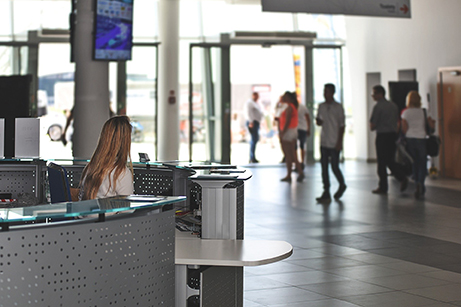7 Common Airport Security Challenges
Airports are critical infrastructure, processing millions of passengers and tons of cargo daily. This makes them vulnerable to growing security threats, from perimeter breaches to cybersecurity risks. Explore seven of the most common airport security challenges and strategies for overcoming them.
1. Perimeter Security

Airports must maintain tight perimeter security to prevent unauthorized individuals from accessing buildings, runways, and taxiways. A spate of physical security breaches at airports in late 2024 and early 2025 have raised awareness of this critical issue. Perimeter breaches endanger staff and passengers and can cause travel disruptions. In some cases, they can cause significant damage to aircraft and airport buildings.
U.S. airports must have secure fencing at least 10 feet tall around their perimeters. The location of buildings, gates, obstructions to the fencing, and access through it are restricted.
High-security gates, guard booths, and other vehicle access controls can help airports maintain an effective perimeter barrier. Delta Scientific offers several sliding gates, such as the TT280 Linear Crash Rated Gate to secure openings from 12 to 30 feet.
2. Baggage Screening
Transportation Security Administration personnel screen more than 4.5 million bags daily. They use a combination of cutting-edge technology and old-fashioned physical searches to complete this monumental task. Staff shortages and an increase in air passenger volume add to the baggage screening challenges at airports.
The Department of Homeland Security works with the TSA and other responsible agencies to develop new technology that improves screening for explosives and other prohibited items.
3. Crowd Management
Crowds pose unique airport security challenges. When large groups of people gather in restricted spaces, it can cause bottlenecks that slow traffic flow. This can disrupt security screening procedures and potentially cause security personnel to take shortcuts. Some unique threats caused by excessive crowds in airports include:
- Obstructed emergency exits and delayed emergency responses
- Frustrated passengers attempting to bypass security measures
- Reduced visibility for security staff and surveillance systems
To manage this challenge, airports can use physical barriers to direct passengers through terminals and security checkpoints. Advanced technologies may improve screening times, allowing traffic to move more quickly. The use of biometrics and other video analytics systems can aid security personnel trying to scan large groups.
4. Parking Control and Vehicle Flows
Thousands of vehicles a day can cause significant traffic and flow problems, which can endanger the safety of passengers and staff.
Traffic controls are effective at limiting vehicle access to designated areas. Traffic teeth and wedge barricades provide access when retracted, but immediately stop cars and trucks when engaged. This flexibility helps keep traffic moving smoothly.
Video surveillance is another useful tool for overcoming airport security challenges posed by high traffic flows. It allows security personnel to identify drivers and passengers linked to suspicious vehicles.
Parking security measures, such as ticket booths and parking control beams, help limit risks associated with congested parking areas. Transit shelters provide secure waiting areas for passengers traveling to terminals, parking lots, and rental car locations.
5. Pedestrian Safety

Airports move millions of people every day, making pedestrian safety a key priority. Security staff must monitor pedestrian traffic while providing safe avenues for movement. They also must have effective tools for limiting access to restricted areas.
In outdoor areas, bollards effectively keep cars and trucks out of dedicated pedestrian areas. Clear pavement markings and signage alert people to crosswalks, waiting or unloading areas, and traffic lanes.
6. Cybersecurity Attacks
The increasing use of technology at airports leaves them vulnerable to cybersecurity attacks. Data breaches can occur at airports and within specific airlines. They undermine passenger confidence in operators and can lead to significant financial repercussions.
Internal threats arise when employees and contractors have access to sensitive customer and system data. A simple mistake, such as failing to use a secure storage method, can expose this information to unvetted outside actors. Regular system updates, staff training, microsegregation, and securing endpoints help reduce cyber threats.
7. Evolving Threats
Airports operate in an environment with constantly changing regulations, which can lead to evolving threats. Malicious actors use novel approaches to bypass existing security protocols. As a result, airport security practices must also evolve to anticipate and stop potential threats.
Overcome Airport Security Challenges With Delta Scientific
Delta Scientific provides barriers, gates, booths, and traffic control products that enable operators to overcome common airport security challenges. Our access control systems are used in airports around the world. Explore Delta Scientific’s airport security products to see how they can help you overcome these challenges and protect your airport.
Share This Story, Choose Your Platform!
